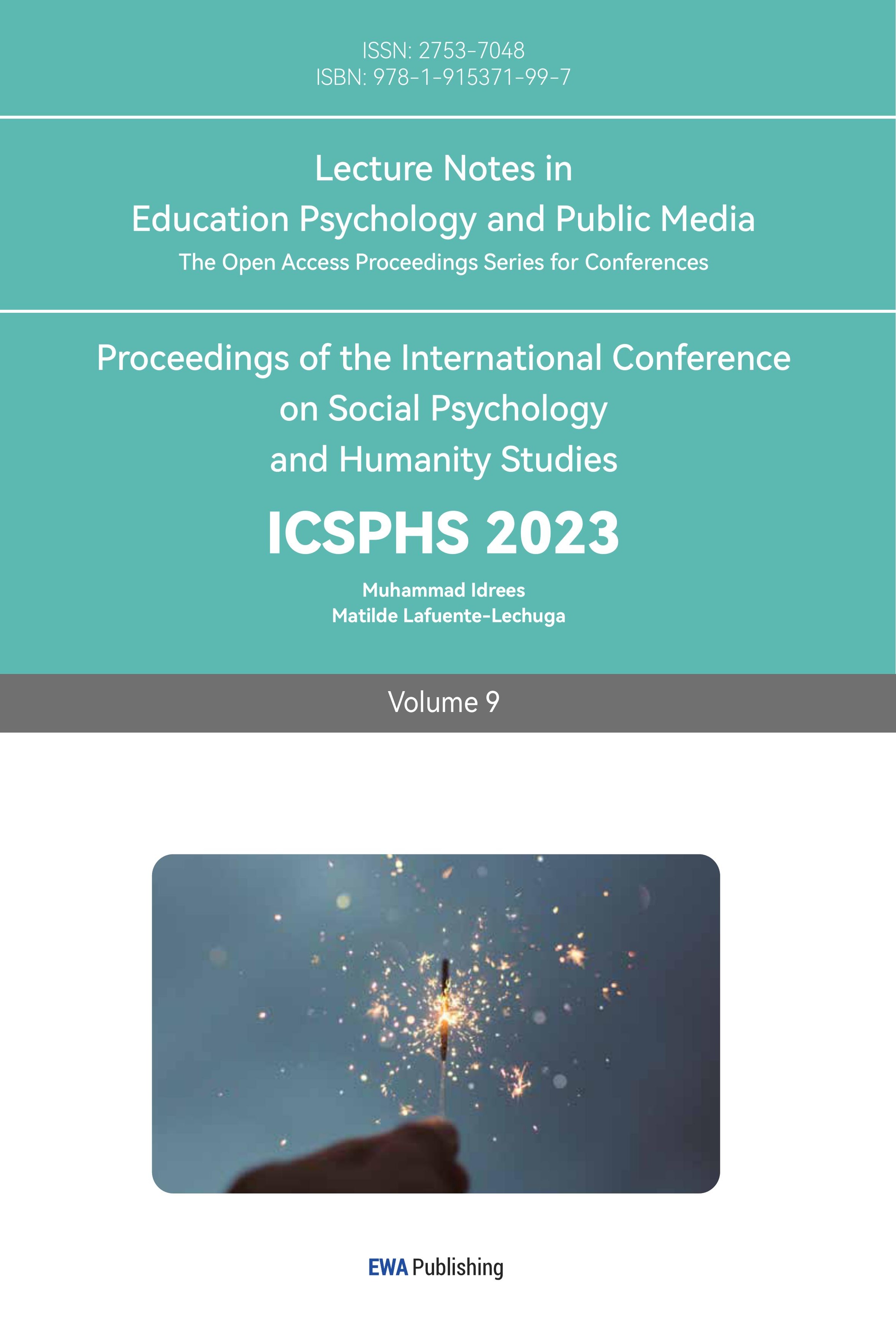References
[1]. Chen Ruisheng. Study the growth dilemmas, causes and countermeasures of left-behind children in rural border minority areas [D]. Yunnan Normal University.
[2]. Zhang Xiaoping. A comparative study on the socialization status of rural left-behind children in ethnic areas under different types of guardianship--an empirical investigation based on five ethnic autonomous counties in Guizhou Province[J]. Journal of Shandong Youth Political College, 2018, 34(2):6.
[3]. Zhang Suqiu. Online media and socialization of left-behind children in rural areas[J]. Journal of South China Agricultural University: Social Science Edition, 2021, 20(3):11.
[4]. Zhu Xudong, Bo Yanling. The comprehensive development of rural left-behind children and the construction of their complete support system[J]. Beijing University Education Review, 2020, 18(3):19.
[5]. Wu Chunman. A comparative study of aggressive behaviors and influencing factors among left-behind children and non-left-behind children in rural China[J]. China Public Health, 2020, 36(8):7.
[6]. Qiao Yan. A survey on the current situation of mental health of rural left-behind children in ethnic minority areas and countermeasures[J]. Language Classes and Beyond, 2022(21):3.
[7]. Gao Yan, Yang Jonah Dong. Educational problems and countermeasures of left-behind children in rural areas of ethnic minority regions: the case of Mao Lawn Primary School in Anlong County, Guizhou Province[J]. Modern Education Science: General Education Research, 2015.
[8]. Prince. Research on the mental health problems of rural left-behind children and analysis of their current situation--a case study of Bijie Experimental Zone[J]. Law and Society: Lenten Journal, 2018(1):2.
[9]. Li Na. A study on the stress situation of rural left-behind children in ethnic minority areas[J]. Educational Teaching Forum, 2020, 000(007):77-78.
[10]. Wang Chenxi. Analysis of the development path of Guizhou's tourism economy based on the background of all-area tourism[J]. Journal of Economic Research, 2020(12):3.
Cite this article
Wang,C. (2023). The Dilemma of Socialization of Children Left Behind in Rural Areas of Ethnic Minority Areas and its Solution. Lecture Notes in Education Psychology and Public Media,9,456-460.
Data availability
The datasets used and/or analyzed during the current study will be available from the authors upon reasonable request.
Disclaimer/Publisher's Note
The statements, opinions and data contained in all publications are solely those of the individual author(s) and contributor(s) and not of EWA Publishing and/or the editor(s). EWA Publishing and/or the editor(s) disclaim responsibility for any injury to people or property resulting from any ideas, methods, instructions or products referred to in the content.
About volume
Volume title: Proceedings of the International Conference on Social Psychology and Humanity Studies
© 2024 by the author(s). Licensee EWA Publishing, Oxford, UK. This article is an open access article distributed under the terms and
conditions of the Creative Commons Attribution (CC BY) license. Authors who
publish this series agree to the following terms:
1. Authors retain copyright and grant the series right of first publication with the work simultaneously licensed under a Creative Commons
Attribution License that allows others to share the work with an acknowledgment of the work's authorship and initial publication in this
series.
2. Authors are able to enter into separate, additional contractual arrangements for the non-exclusive distribution of the series's published
version of the work (e.g., post it to an institutional repository or publish it in a book), with an acknowledgment of its initial
publication in this series.
3. Authors are permitted and encouraged to post their work online (e.g., in institutional repositories or on their website) prior to and
during the submission process, as it can lead to productive exchanges, as well as earlier and greater citation of published work (See
Open access policy for details).
References
[1]. Chen Ruisheng. Study the growth dilemmas, causes and countermeasures of left-behind children in rural border minority areas [D]. Yunnan Normal University.
[2]. Zhang Xiaoping. A comparative study on the socialization status of rural left-behind children in ethnic areas under different types of guardianship--an empirical investigation based on five ethnic autonomous counties in Guizhou Province[J]. Journal of Shandong Youth Political College, 2018, 34(2):6.
[3]. Zhang Suqiu. Online media and socialization of left-behind children in rural areas[J]. Journal of South China Agricultural University: Social Science Edition, 2021, 20(3):11.
[4]. Zhu Xudong, Bo Yanling. The comprehensive development of rural left-behind children and the construction of their complete support system[J]. Beijing University Education Review, 2020, 18(3):19.
[5]. Wu Chunman. A comparative study of aggressive behaviors and influencing factors among left-behind children and non-left-behind children in rural China[J]. China Public Health, 2020, 36(8):7.
[6]. Qiao Yan. A survey on the current situation of mental health of rural left-behind children in ethnic minority areas and countermeasures[J]. Language Classes and Beyond, 2022(21):3.
[7]. Gao Yan, Yang Jonah Dong. Educational problems and countermeasures of left-behind children in rural areas of ethnic minority regions: the case of Mao Lawn Primary School in Anlong County, Guizhou Province[J]. Modern Education Science: General Education Research, 2015.
[8]. Prince. Research on the mental health problems of rural left-behind children and analysis of their current situation--a case study of Bijie Experimental Zone[J]. Law and Society: Lenten Journal, 2018(1):2.
[9]. Li Na. A study on the stress situation of rural left-behind children in ethnic minority areas[J]. Educational Teaching Forum, 2020, 000(007):77-78.
[10]. Wang Chenxi. Analysis of the development path of Guizhou's tourism economy based on the background of all-area tourism[J]. Journal of Economic Research, 2020(12):3.









